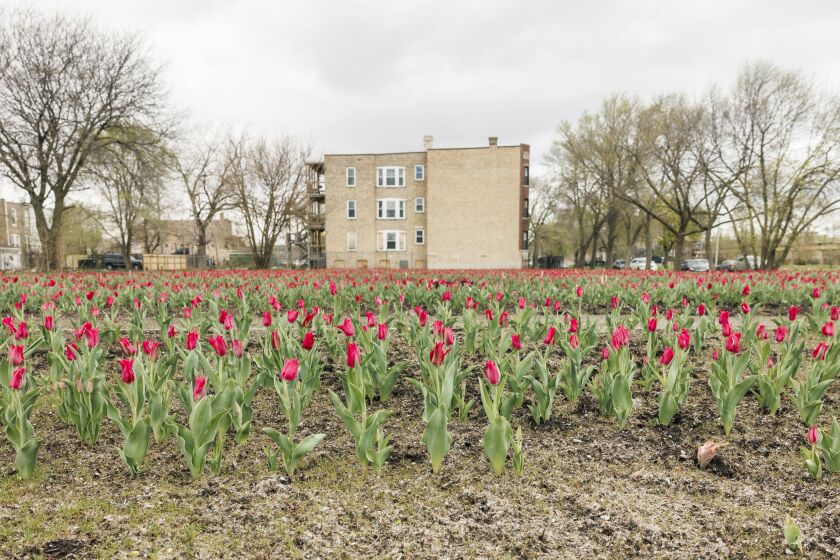South Side artist Amanda Williams took the red from where it was — inked into the ledgers of private lenders — and put it out where everyone could see.
Williams transformed several vacant lots where houses once stood but were left to rot into fields and fields of red tulips.
The result: “Redefining Redlining,” an artwork intended to highlight the systemic disinvestment that led to the demolition of the houses that stood there and throughout Chicago’s Black neighborhoods after lenders began assigning the areas higher interest rates.
“We’re planting the tulips in the shape of houses that should exist,” Williams told the Sun-Times before planting the bulbs in the Washington Park neighborhood last year. “Imagine the block if all this still existed. Imagine the families that would have lived here.”
Six months later, the 100,000 tulip bulbs planted around 53rd and Prairie Avenue have begun to bloom, creating a red haze visible from the passing L train. The blooms are expected to last until the end of April. Williams is planning an event at the site on April 29.
She chose tulips for their look and as a reference to tulip mania, when Dutch tulips in the 1600s briefly came to be more valuable than a house. The $47,000 worth of tulips mainly come from Holland.
Williams hopes the work will spark conversation around what’s been the obsession of her career — how the South Side wound up so sparse compared to the rest of Chicago.
Williams, 48, began asking that when she would head downtown from Auburn Gresham, where she grew up, and would notice how the city became brighter after passing the Robert Taylor Homes, the wall of public housing complexes along State Street south of Pershing Road that were demolished in 2007.
That led her to study architecture, “naively” thinking, she said, the South Side could literally build a brighter future before realizing the problem lay deeper, namely in discriminatory practices, such as redlining.
“You get to understand there are other forces at play that determine how you move through the world,” she said.
Williams found she could better address the question as an artist. It’s been the theme of some of her other work, like her painting of condemned South Side houses around a decade ago or an exhibition of sculptures made from demolished houses in 2016.


Her work has gained recognition internationally. Last year, she was among three Chicagoans named MacArthur fellows and before that she had an exhibition at the Venice Biennale of Architecture.
But Williams remains rooted on the South Side. She works out of a studio in Pilsen and lives in Bronzeville near the tulip-filled lots.
Williams and a team of graduate students are researching who lived in the houses that stood there and for many, that’s what the work is about.
“They make you think about who lived there and why aren’t they there anymore,” said Esther Grisham Grimm, longtime executive director of 3Arts, a Chicago-based organization that has supported Williams’ work for years.
Grimm said Williams’ colorful approach belied the complex thought behind it.
“There’s a kind of humor, an irony,” she said, “but, more than anything, a hard-hitting punch of look what happened here and what’s happening here now.”
The work is about the future for others.
Ghian Foreman, the president of Emerald South Development Collaborative, helped Williams organize volunteers to plant the bulbs last October. He views the work as a call to action.
“It’s the artist who foretells the revolution,” said Foreman, 49.
That revolution involves South Siders becoming stewards of their neighborhoods, where many vacant lots are seen as a liability.
“Trash collects — and, if you live in that community, that becomes normal, so it becomes nothing to you to throw down trash,” he said.
Foreman already has been converting vacant lots into gardens through Emerald South’s Terra Firma program, but he hopes that the idea catches on with others.
“Ideally the community will come together to come up with a plan to redevelop the land in a healthy way,” he said.
While the tulips are in bloom, many are just taking a moment to smell the flowers.
On a weekday afternoon, Patricia Evans, a Hyde Park resident that helped plant the bulbs, stopped by to check out the fruits of her labor.
“It looks great. You can even see that red driving up,” said Evans, 79.
Megan Okuesa, a resident of one of the buildings next to the tulips, said dozens of people have been stopping to take pictures of the flowers or to just look at them.
“At first I thought they were going to build something, maybe housing,” said Okuesa, 35, recalling when the teams of volunteers were planting the bulbs.
When flowers came up, she was pleasantly surprised.
Okuesa, with her four-year-old twins Chloe and Chance in tow, arrived around the same time as Evans.
“Flowers!” yelled Chloe, making a beeline for the closest plot.
As Chance raced to catch up to Chloe, Okuesa called out after them.
“You can look, but don’t touch.”
Michael Loria is a staff reporter at the Chicago Sun-Times via Report for America, a not-for-profit journalism program that aims to bolster the paper’s coverage of communities on the South and West sides.









